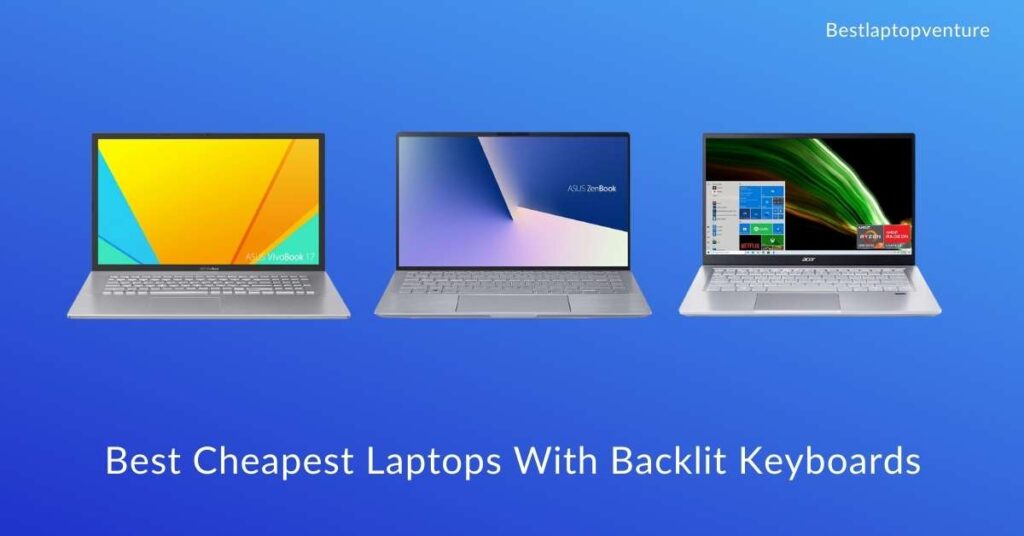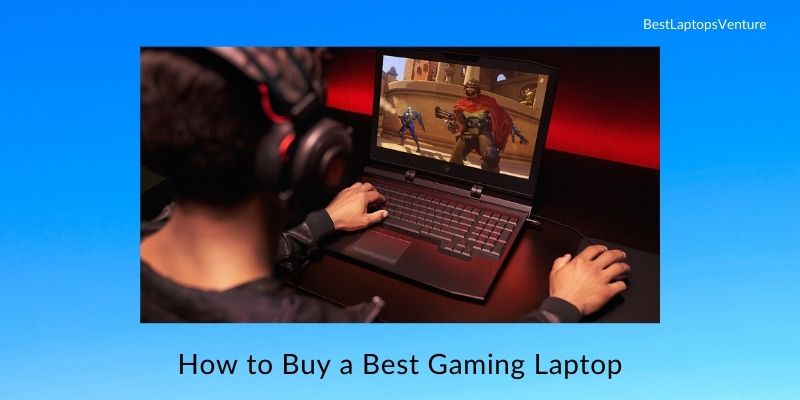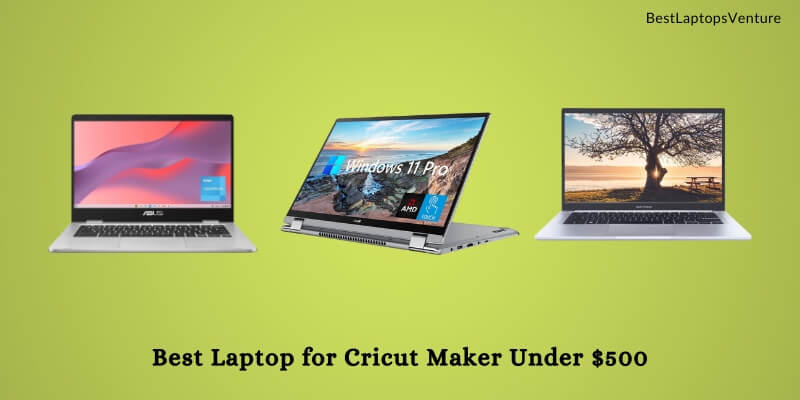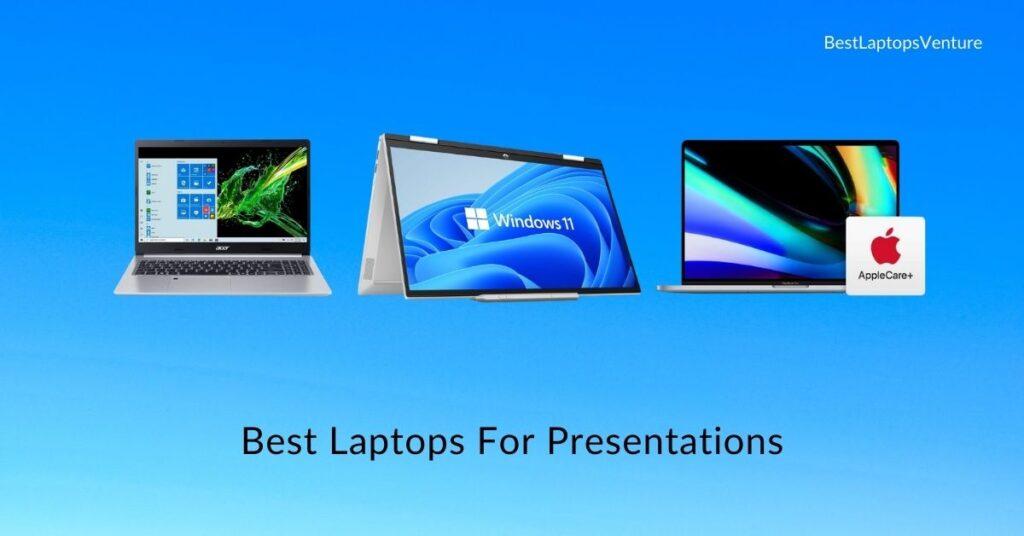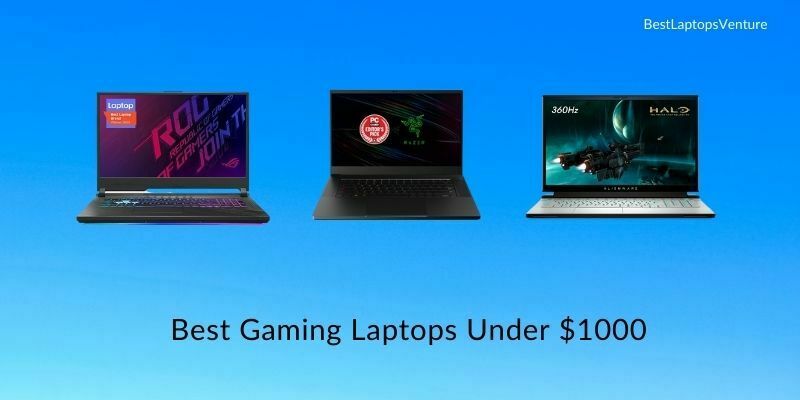
We’ll examine the ins and outs of premium—well, somewhat premium—best gaming laptops under $1000 in 2025 in this post to help you make an informed purchasing decision.
Additionally, we’ve compiled a list of the best alternatives on the market today that provide exceptional performance at an affordable price.
For less than $1,000 (or less), you may acquire a laptop capable of providing an optimum gaming experience. While all of the laptops included in this guide are competent, some stand out more than others due to their pricing or the additional features that assist them to give a more fabulous in-game experience.
Each of the nine gaming laptops we’ve chosen has unique advantages and disadvantages, which we’ll discuss in detail along with the various specs of the graphics card, CPU, RAM, display, storage, and ergonomic aspects.
This means you are not restricted to low-resolution gaming on these computers and can have an immersive experience when playing Apex Legends, CS: GO, PUBG, Fortnite, and Minecraft.
Finally, if your budget for a gaming laptop is less than $1,000, one of the alternatives below should meet your demands. We also reviewed gaming laptops under $1200.
Top 9 Best Gaming Laptops Under $1000 [Recommended]
We’ve compiled a list of the best gaming laptops under 1,000 dollars for 2025 to address a range of needs and priorities—from cost-effectiveness and improved battery life to pro-level gaming capabilities.
1. Best Versatile Gaming laptop: Lenovo Legion 5
[amazon box=”B0BT7XCVRL”]
Lenovo’s Legion 5 is one of the best gaming laptops available for less than $1,000. Unlike a standard gaming laptop, which prioritizes a high-end graphics card above available RAM, Lenovo’s Legion 5 is more focused on enhancing professional resources.
The Legion 5 is built on a sturdy and semi-rugged chassis that weighs close to 5.28 pounds. Despite its unsurprising look, this Lenovo-branded laptop is one of the most searched laptops on the market, owing to its vivid 15. 6-inch full HD display.
Its 15.6-inch full HD IPS display features a 165Hz refresh rate and less than 3 ms response time that boasts 100% sRGB color accuracy. It also includes Dolby Vision® and AMD FreeSyncTM Premium.
The processor is best aided by the 64GB of DDR4 RAM, which can easily handle even the most complex 3D projects, browser indulgences, and concurrent gaming requirements.
In terms of graphics and gaming performance, you retain access to the best NVIDIA GeForce RTX 3050 Ti GPU with Turing architecture. When combined with 4GB of video RAM, the current graphics card is capable of handling nearly any mid-range AAA game at 720p or even high 1080p settings.
Lenovo provides dual storage compatibility, utilizing the 512GB NVMe SSD as the boot-up resource for the Windows 11 operating system contained therein.
In this gaming laptop, you’ll find a powerful AMD Ryzen 5 5600H processor, housed in a clean, minimalist chassis
While the processing needs are met at remarkable rates thanks to the 12MB cache memory, high-bandwidth system memory, and an ultrafast CPU, this Lenovo laptop also prioritizes professional work with a backlit keyboard, passable camera, and a high-fidelity acoustic setup.
Despite the various professional upgrades, our reviewers are deeply disappointed by the device’s short 4-hour battery life. However, if you’re looking for a desktop alternative, you might consider the same.
PROS
- Very good performance
- Excellent screen
- User-upgradable RAM and storage
- Excellent hardware controls
- Decent value for the money
CONS
- 720p webcam
- Fairly heavy at 5.4 pounds
2. Best All-rounder Gaming Laptop: ASUS ROG Strix G15
[amazon box=”B0B9RZCFSR”]
This is the first significant release of AMD’s Advantage line of laptops, which includes RDNA 2 core components and must adhere to a strict power and performance efficiency requirement.
The ASUS ROG Strix G15 Advantage Edition will delight you in most aspects. The NVIDIA GeForce RTX 3050 GPU and AMD Ryzen 7 6800H CPU are the true standouts here, and you won’t find gaming performance like this in any other laptop at this price point.
While the 1080p 144Hz display is an excellent feature at this price range, a refresh rate this high on anything but the most powerful system is significantly overkill, and you’re unlikely ever to reach this limit in terms of frames per second.
Again, the claimed 3ms reaction time is impressive for a laptop at this price point – and a welcome bonus for competitive gamers. While the G15 Advantage Edition falls short of Razer and Alienware in regards to color reproduction, contrast, and brightness, it does the job while gaming.
Overall, the laptop has a great appearance – with some red ‘gaming’ accents and various colored WASD keys – but it would be as at home in an office situation. Except for the hefty bottom bezel, the bezels surrounding the display are pleasingly small.
The laptop is not the lightest on the market in terms of ergonomics, but this is a necessary trade-off for a laptop with this much power and battery life.
On to the battery life: anticipate about 9 hours while performing non-graphically intensive office work and web browsing, which is rather good for a gaming laptop with solid components and says volumes about AMD Advantage machines’ stated power efficiency. However, battery life when gaming is still about what you’d expect from the majority of gaming laptops – approximately an hour.
You can see that ASUS and AMD have made a concerted effort to emphasize the gaming aspect of these computers, excluding the webcam and SD card reader to save money, which may turn off some users. Additionally, the 1TB PCIe NVMe SSD is half the size it should be and may benefit from an update / additional HDD.
Finally, one aspect that is typically overlooked but is actually quite excellent with this laptop is the audio. While it does not quite reach the lofty heights of a MacBook Pro, it does have good bass tones and is adequate for viewing Netflix and the like.
The ASUS ROG Strix G15 Edition’s primary shortcoming is its RAM. As has been discovered by several tests since the laptop’s debut, the base RAM is clocked at a relatively good speed and has been claimed to reduce performance by as much as 12% in certain severe instances, though generally by no more than 10% – an intolerable bottleneck by any measure.
Fortunately, you can resolve this issue by upgrading the RAM, The RAM is the latest 16GB DDR5, and you can extend it up to 32GB.
Nonetheless, the ASUS ROG Strix G15 Edition redefines what a gaming laptop at this price point is capable of, and we wholeheartedly recommend it.
PROS
- Excellent performance
- Cool at most touchpoints
- Comfortable keyboard
- Dolby Atmos audio
- 144Hz screen
- Good battery life
CONS
- No biometric authentication
- USB speeds limited to 5Gbits/sec
3. Best Functional Gaming Laptop: Acer Predator Helios 300
[amazon box=”B0B53GFQWP”]
A 15.6-inch computer for a little under $1000, the Acer Predator Helios 300 PH315-55-70ZV is a design and functionality miracle.
With the newest 12th generation Intel Core i7-12700H CPU, 16GB DDR5 RAM, 512GB SSD display, and NVIDIA GeForce RTX 3060 graphics, this Predator is capable of running the majority of contemporary AAA titles at 144Hz without stuttering.
The FHD screen features an IPS display for optimal viewing experience from a variety of angles. Additionally, this computer features a seven-hour battery life, which contributes significantly to the mobility of an already lightweight and thin laptop (4.85 lbs, 0.9″).
While this laptop is priced at around $1,000, it does not skimp on the display’s attractiveness. Along with the fast refresh rate, you get 300 nits of brightness and a 72 percent NTSC color gamut.
This brings the colors and textures to life, preserving and enhancing the flourishes. In addition, an AeroBlade cooling system with two steel fans keeps everything cool (3D).
Acer has assured us that this product meets the highest design requirements. Red highlights and geometric lines are used throughout the construction, which contributes to the dramatic appeal of the black chassis.
This laptop’s standout feature is its amazing sound; Acer True Harmony and DTS X Ultra work together to provide robust, clear audio that creates breathtaking gaming experiences.
Notable features include abundant USB ports, a lighted keyboard, and Wi-Fi 6. As a result, connecting to peripherals and accessing the Internet will be a breeze. Additionally, it has a high-definition webcam with Super High Dynamic Range (SHDR) that enables you to communicate with your gaming friends via high-quality video.
PROS
- Bright and colorful display
- Mediocre audio
- Slow SSD
- High system performance
- Comfortable keyboard
- Solid performance and graphics
- Remarkably cool
- Reasonable value
- Great price for an RTX 3060 GPU
CONS
- Mediocre audio
- Average battery life
4. Best Aesthetic Gaming laptop: ASUS ROG Zephyrus G14
[amazon box=”B08DDJB4T5″]
If your budget is less than $1000, the ASUS ROG Zephyrus should always be considered. ASUS ROG gives you one of the best gaming laptops by combining the AMD Ryzen 7-4800HS CPU (Beats Intel i7-10750H) with the NVIDIA GeForce GTX 1650 graphics processor. This is the laptop for anyone who places a premium on gaming performance.
It features a 14-inch full HD IPS display. Additionally, this computer features a 1TB PCIe NVMe SSD and 16GB of RAM, making it the ideal gaming machine. A sophisticated cooling system contributes to the ASUS ROG Zephyrus’s overall excellence as a gaming platform. Furthermore, it is equipped with robust hardware that enables it to take on everything you throw at it.
ASUS offers this laptop with either a Geforce GTX 1660 Ti or a Geforce RTX 2060 GPU, different storage capacities (1TB HDD and 512GB), and a 144Hz/240Hz display. Choose the 240Hz option since it is more efficient and produces more than 300 nits of brightness.
The laptop’s battery life is roughly 5 hours when used for light gaming. One disadvantage is the thermal design, which causes the laptop to overheat quickly, as well as the Max Q-only GPU choice.
However, it provides an excellent gaming experience and doubles as a multi-purpose, ultra-portable laptop weighing approximately 3.64 pounds (2 kg).
PROS
- Demanding games are playable
- Portable design
- Low-glare, High-quality display
- Excellent CPU performance for its size
- G14 chassis is thin, light, and very compact
- Decent I/O options
- Comfortable keyboard
- Good battery life
CONS
- Display could be more vibrant
- Fans spin almost constantly
5. Best Multi-purpose Gaming Laptop: Acer Nitro 5
[amazon box=”B0BR8Q6WGF”]
Despite being far less expensive than some of the other alternatives on this list, the Acer Nitro 5 is one of the best gaming laptops under $1,000 presently available.
The Acer Nitro 5 is powered by a 12th Gen Intel Core i5-12500H CPU, an RTX 3050 graphics card, 16GB DDR4 RAM, and a 512GB NVMe PCIe SSD. Additionally, it features a 15.6-inch 1080P display with a 144Hz refresh rate.
The i5-12500H and the latest NVIDIA GeForce RTX 3050 GPU is powerful enough to run virtually any game at its highest settings on a 1080P display. Additionally, the 144Hz refresh rate enhances the performance of games. This is especially true for competitive games like Rocket League, Call of Duty, and Fortnite that require split-second judgments.
The one disadvantage of this Acer gaming laptop is that it comes with a limited amount of storage out of the box. Although the 512GB SSD is speedy, it is unlikely to be large enough to hold the average PC gamer’s collection. You may always purchase an extra 2.5′′ drive and add it to the Helios 300 if you want additional storage.
The basic truth is that the Helios 300, with its i5-12500H CPU and RTX 3050 GPU, will not deliver the performance of the Lenovo Legion mentioned above.
However, it is $200 less expensive—so you can save some money without compromising performance.
PROS
- Solid performance all around
- Plenty of connectivity
- Full HD IPS display
- Excellent price
- Good graphics performance
- Excellent battery runtimes
- AC Wi-Fi
- Fast NVMe SSD
- Long battery life
CONS
- Uninspired design
- HDMI-only for display output
6. Best Performative Gaming Laptop: MSI Katana GF66
[amazon box=”B08FD8Z37N”]
MSI’s latest gaming laptop, the MSI Katana GF66, outperforms every other sub-$1000 notebook on the list in terms of sheer gaming performance, processing power, and even multitasking capabilities. What makes it one of the best purchases is the supercharged graphics support, which is not limited to gaming but easily accommodates your professional demands.
Why is it the best of its kind?
The NVIDIA GeForce RTX 3050 Ti graphics card, with its broad gaming capabilities, remains the standout. If you’re serious about gaming performance, this GPU combined with 4GB VRAM is more than capable of handling the latest AAA titles like Deathloop, Monster Hunter Stories 2, Resident Evil Village, and others. With 1080p settings, you can play the majority of these games at a constant frame rate of over 110fps.
The latest 12th Gen. Intel Core i7-12650H processor SoC is best-in-class, allowing you to work with a 12-core architecture and a maximum clock speed of 4.7GHz. As a result, controlling NPCs, gaming environments, and other features on this laptop is a piece of cake.
In addition, 16GB DDR4 RAM works in tandem with the processor, allowing you to run gaming modifications, extensions, and other concurrent operations without experiencing latency.
If you plan on keeping games, files, and movies on the device, the 512GB NVMe SSD might be extremely useful. Additionally, the SSD guarantees that the Windows OS boots almost instantly.
MSI’s Nahimic speakers, Wi-Fi 6, a slew of high-speed USB and HDMI connections, and top-of-the-line Cooler Boost technology for controlled heat dissipation ensure that productivity is never an issue.
The MSI Katana GF65 has an attractive appearance, with surprisingly slim proportions despite the 15.6-inch screen. This laptop is under 4.63 pounds and includes a rugged, configurable, and backlit keyboard.
For display enthusiasts, the current 1080p screen assumes a refresh rate of 144Hz, which is plenty to get you through the majority of games without experiencing even a single frame drop.
While the battery life is limited to 6.5 hours with moderate usage, the remaining specifications are more than sufficient to earn the MSI Katana GF66 the top spot on the list.
PROS
- 144Hz display
- Includes an RTX 3050Ti
- Great gaming performance
- Fast SSD
- Excellent price
- Good gaming keyboard
- Sleek, compact, highly portable design
- Efficient cooling
- Powerful speakers
CONS
- Few connections
- Display could be more vibrant
7. Best All-Rounder Gaming Laptop: Razer Book 13
[amazon box=”B09HJGCL5Q”]
The Razer Book 13 is an excellent choice for the top spot on our list of laptops under $1,000, owing to the ingenuity it brings to the table. To begin, the aluminum-clad, unibody construction significantly improves the laptop’s overall design, making it enviably slim and compact.
On the other hand, the display is crisp, color-correct, and extremely gamer-friendly, due to the 120Hz refresh rate. While the Book 13 is an all-purpose computer, the increased screen refresh rate easily qualifies it as a competent gaming laptop by minimizing screen tearing and ghosting.
The thinner paneling adds to the visual brilliance by amplifying the 1080p screen’s screen-to-body ratio.
The Book 13’s memory allotment is unquestionably superior, with 16GB of high-speed DDR4 RAM available. However, what makes this system unique is the dual-channel RAM module, followed by upgradeability.
Apart from the display, the processing cluster, presided over by the 11th generation Intel Core i7-1165G7 CPU and its related firepower, merits special notice. The current CPU features a 12-threaded design, which makes it ideal for 3D modeling, rendering, video editing, and other creative pursuits.
The Intel Iris Xe graphics card is a lightning-fast supercharger for today’s most popular games.
The 1920 x 1080 pixel resolution of the display increases the clarity of the viewing angles and significantly enhances sunshine visibility.
When it comes to productivity, the Chroma backlit keyboard is a must-have, followed by powerful speakers. However, the thermal and heat-dissipating hardware steals the show. Despite the Book 13’s unique cooling technology, Razer has made it one of the lightest and best gaming laptops under $1,000 on the market.
Other useful specifications connected with the Book 13 include a pre-installed Windows 11 operating system, a slew of functional ports and connection options, including Wi-Fi 6, a Thunderbolt connector capable of 40gbps data transmission, and more.
In addition, the 6-hour battery life, as claimed by Razer, is adequate for a gaming laptop.
PROS
- Gorgeous, pristine design
- Plenty of ports
- Solid gaming performance
- 11th Gen Intel and EVO-certified hardware flies
- Best in-class SSD
- Brilliant IGZO display
- Attractive 16:10 edge-to-edge display
- Long battery life
- Comfortable keyboard with per-key RGB lighting
CONS
- Runs a bit warm
- Mediocre speakers
8. Best Budget-Friendly Gaming Laptop: HP Victus
[amazon box=”B0B57PFXLR”]
HP’s Victus range of cheap gaming laptops is another good option.
HP Victus is a line of significantly less expensive gaming laptops from HP. As is customary with budget gaming laptops, the HP Victus is uninspiring, with the emphasis being on cramming the most up-to-date components for the money.
This year’s edition features the newest CPUs from Intel and AMD, but many stores still sell last year’s components at a discount. Perhaps the most compelling feature of the HP Victus is its design, which will appeal to those seeking a more sophisticated, thinner chassis than is often found in laptops at this price point.
If you’ve always felt that a 15-inch laptop is too tiny to play games and a 15.6-inch laptop is too large to carry about, the HP Victus is the laptop for you. It is the only gaming laptop available in a 15.6-inch form factor and strikes the ideal mix between big-screen enjoyment and portability.
NVIDIA GeForce RTX 3050Ti 4GB GDDR6 is integrated, which is very fast and sharp.
However, because it has a high refresh rate 144 Hz panel, gaming on this laptop will be more enjoyable than on other gaming laptops discussed here, and it is an excellent screen for everyday work. However, you may need to play certain games in medium resolution in order to obtain playable frames.
Additionally, the build quality of this HP Victus is outstanding, and with a polycarbonate chassis, it is a very lightweight laptop at 4.4 pounds despite its huge size. On the other hand, its black and green color scheme is a point of fascination for me.
Personally, I’m not a fan, but some of my coworkers are. Particularly the green backlit keyboard, which garners much attention.
In all, the HP Victus 16.1 is an excellent gaming laptop for individuals who enjoy playing games on a huge display but don’t want to travel with too much weight on their backs.
While it lacks the high-refresh-rate screens that other gaming laptops in this price range provide, gaming on bigger displays is always more enjoyable.
PROS
- Low price
- Decent 1080p gaming performance
- Can double as a work laptop
- Latest AMD CPU
- Lots of ports and IO
- Portable design
- Good display
- Surprisingly good webcam
- Bigger touchpad
CONS
- All-plastic construction
- Not good battery life
9. Bestseller ASUS laptop: ASUS TUF F15
[amazon box=”B0BFR2R8N6″]
You do not need to invest a lot of money to have excellent gaming performance. The ASUS TUF F15 performs admirably. It offers excellent viewing angles and a nice sheen.
The screen’s primary disadvantage is its hue. In comparison to high-end laptops, the color seems washed out. It utilizes just 59% of the SRGB color space.
While many gamers find it adequate for gaming, it is insufficient for screen pictures or video editing. With a 144Hz display, you’re going to need a 1TB solid-state drive, 32GB of RAM, and an Intel Core i5-11400H CPU.
However, if you want a 1080P laptop capable of playing any game without difficulty, the ASUS TUF F15 is worth considering. Our is a more inexpensive alternative than the others on this list.
Nvidia’s GeForce RTX 3050 graphics card is used. As a result, you’ll have no difficulty competing in competitive games such as Overwatch, Fortnight, Dota 2, and Apex Legends. True, 1TB of storage is on the low end, and the RAM can be increased to 64 GB. Fortunately, upgrading to RAM and a solid-state drive is simple.
Additionally, the Asus TUF F15 ‘s sturdy construction is a benefit. It is constructed to Mill STD 810 standards, making it very robust and even heavier than the majority of 15.6-inch laptops. One drawback of the design is that all ports are located on the laptop’s left side.
It includes the majority of the ports you’ll need but lacks an SD card reader and a CD / DVD drive. To improve gaming performance, I recommend upgrading to dual-channel. CPUs appreciate their memory bandwidth for this reason.
The keyboard is illuminated and numbing. The keyboard is, I’m sure, a chiclet keyboard, but honestly, it has one of the best chiclet keyboard sensations. Because you can only have one color at a time, it is not entirely RGB.
Nevertheless, this is a pleasant keyboard with reasonable key travel and a crisp click. Thanks to two fans with anti-dust technology, it keeps cool, and the battery life is enough for a gaming laptop.
PROS
- Solid 1080p gaming performance (with a caveat)
- Good thermal management
- Relatively good battery life
- Quiet cooling fans
- Smooth 240Hz screen
- Reliably smooth gameplay
- Battery life lasts beyond a workday
- Optional USB-C charging
- Plenty of ports
CONS
- No biometric features
- Fans run loud to keep it cool
A Simple Checklist for the Best Gaming Laptops Under $1000
While seeking an under $1000 & 144Hz gaming laptop, keep the following in mind:
A fast CPU (Intel Core i7 or above) is required to fuel your high-intensity gaming sessions. A high refresh rate is useless unless your CPU can keep up.
A dedicated GPU: Integrated graphics are unlikely to be sufficient for gaming on a fast track. Consider purchasing a laptop with a dedicated GPU (e.g., NVIDIA GTX). If you have the cash, you may also look at NVIDIA RTX GPUs for stunning visual effects powered by real-time ray tracing.
Anti-glare and IPS panels: If you’re investing in a high-refresh-rate monitor, chances are you’ll be looking at it for extended periods. An anti-glare display and IPS compatibility (In-Plane Switching) ensure a strain-free and comfortable viewing experience in all viewing postures.
While the best method to minimize screen tearing or stuttering is to invest in a laptop with a high refresh rate (144Hz or at least 120Hz), you may also investigate technologies such as NVIDIA G-SYNC or AMD FreeSync. By synchronizing the display panel and the graphics card, these solutions eliminate screen tearing and ghosting. Thus, the display will update only when the card transmits a frame, ensuring that the two remain in sync regardless of the frame rate.
A better sound system: Games with fast-paced action rely largely on sound to create realistic, engrossing worlds. A laptop with complementary acoustics to the 144Hz display will aid in achieving the best results.
The Advantages and Disadvantages of an Under $1000 Gaming Laptop
Gaming on a laptop seemed unthinkable only a few years ago. However, advancements in design and clever heat management technologies make it feasible to execute complex multimedia activities on tiny devices.
Let’s take a short look at some budget gaming laptops and see what they have to offer.
Pros:
Numerous affordable gaming laptops now have sufficient processing power to run games like Fortnite and Overwatch at moderate to high settings.
Manufacturers have responded to current audiences’ demands by equipping affordable gaming laptops with a slew of premium features.
For example, it is feasible to enjoy the glitz of NVIDIA RTX graphics and a high refresh rate on a gaming computer priced at around $1,000. Additionally, Bang & Olufsen offers fine-tuned audio as well as surround sound in your headphones.
You save money that you can spend on gaming accouterments like controllers, external gadgets, and mouse.
Many gamers enjoy keeping up with the current trends and purchasing new laptop models as they become available.
If you acquire a budget-friendly notebook today, you will have more options when it comes time to upgrade a few years from now. You will avoid having to make two large investments within a short period of time.
Frequently, inexpensive gaming laptops serve as fantastic multimedia machines for film fans, editors, photographers, painters, and other creative professionals.
They may be used to create and modify multimedia material, which significantly increases their utility. While you did not rob a bank to obtain a gaming laptop, you did get a flexible, multifunctional computer.
Cons:
You’ll want to exercise extreme caution while shopping for a gaming laptop in the budget category. Numerous selections have a shoddy design, low-quality keyboards, and fragile construction.
Upgradeability is not often a strong point of cheap laptops. You are locked into the specs you purchase, and if your demands change, you will almost certainly need to buy a new laptop.
It’s still impossible to replicate the desktop-league experience on gaming laptops, particularly those priced around $2000.
This is partly due to the cooling mechanism—desktops nearly always have superior airflow, which results in increased sustainability and long-term performance (Laptops are attempting to equalize this with anti-dust and adjustable fan speed technology.).
Should You Buy a Gaming Laptop for Less Than $1000?
Cheap gaming devices are available at a range of price points—from as low as $500 to as much as $1000. When you purchase a laptop for less than $1000, you are investing in the mid-range, which means you will still have access to a number of high-end capabilities.
These laptops provide robust processing and compelling graphics, the two pillars of gaming. As a result, they’re excellent choices for anyone who enjoys gaming and wants to save money.
Despite their advantages, inexpensive gaming machines are not suited for everyone. You should only get a low-cost gaming buddy if:
You like gaming but are not, shall we say, obsessed with achieving the most incredible possible level of gameplay.
You are ready to make concessions on some parameters, such as refresh rate, storage capacity, or mobility. For example, few budget gamers can boast a refresh rate of 240Hz, more than 512GB of storage, or a chassis weighing under 4–5 pounds.
If your requirements change, you’re open to switching to a more expensive laptop shortly.
You are not a purist when it comes to immersive sound. While several laptops under $2000 now have distortion-free audio, the majority of gaming notebooks continue to struggle with this.
This is due in no small part to the high-speed fans required by laptops for heat dissipation. Desktops and high-end laptops typically have more efficient (and quieter) cooling systems, which contributes to improved acoustics.
Notably, you can also get gaming laptops in the $800–$1000 bracket. Several of these gadgets are merely ordinary PCs that can also be used to play various games—at best on low settings.
However, expecting such devices to deliver the adrenaline rush associated with rich graphics or the breakneck speeds found in many AAA games would be unrealistic.
What to Look for in a Gaming Laptop Under $1000
To be honest, these laptops are far from “affordable.” However, they are very affordable when compared to PCs priced at more than $2500. Having said that, they must nevertheless provide adequate power for your gaming endeavors.
Therefore, when shopping for a gaming laptop that meets your requirements, be sure that it meets the following criteria:
A capable CPU: The majority of laptops in this category include an Intel Core i7 processor, which has been demonstrated to be capable of running modern games such as PUBG and Fortnite.
Additionally, you may seek an AMD counterpart; AMD CPUs are very adept at multitasking and are also more affordable.
However, it is critical to avoid settling for a subpar CPU, since this would severely limit your gaming and the variety of options available.
Additionally, it is advantageous if the CPU allows overclocking. Concerning the number of cores, you may get away with four or six; there is little use in going overboard here.
Achieve an adequate RAM and storage configuration: Aim for at least 16GB RAM and 512GB of storage. In addition, the laptop would include an SSD (solid-state drive) for faster read/write rates and loading in an ideal world. SSDs also offer a longer lifespan and a faster startup time, which are advantageous for demanding activities like gaming.
A better alternative is to get a combination of SSD and HDD (hard disk drive). Thus, your essential gaming files may reside on the SSD, while the rest of your data can reside on the HDD.
However, few laptops priced under $1,000 now provide this combined storage.
Certain laptops make memory and storage upgrades simply via easily accessible slots. This is advantageous if you desire to update the specifications of your laptop without purchasing a new computer entirely—a situation that occurs far too frequently among gamers.
Effective heat dissipation: Gaming is a CPU-intensive endeavor that creates an enormous amount of heat. Unless your laptop is equipped with a functioning heat dissipation system, the build-up will impair your experience.
Consider cooling solutions that make efficient use of available airflow. Anti-dust innovations keep the internal components cool and functioning well. Certain laptops in this league include aero-blade fans for increased airflow.
Dedicated graphics card: This is virtually required if you intend to play high-end games at their highest settings. For games that require many transitions, intricacies, and special effects, integrated graphics simply will not be enough.
While an NVIDIA GTX card is capable of supporting a wide variety of modern games, you may also choose an NVIDIA RTX card.
Particular sub-$1000 gaming laptops do come equipped with RTX’s magnificence, including real-time ray tracing, increased performance, and artificial intelligence.
Vivid display: A laptop that qualifies as a gamer must have a bright and fascinating display. For minimal external interference, go for an FHD display with a thin bezel. It is suggested that you get a 15.6″ (minimum) or a 17″ display, depending on your needs.
While the former is more portable and well-suited for outdoor activities, the latter is more desktop-like.
Additionally, verify that the display is equipped with an IPS panel (In-Plane Switching). This is critical to ensuring that you can view the screen from a variety of angles/positions without experiencing distortion.
The refresh rate, or the number of times your screen refreshes each second, is a critical element of the display.
A suitable measure to use is 144Hz; you will struggle to locate laptops with 240Hz in this price range. Additionally, look for a wide color spectrum (100 percent sRGB is ideal), a fast reaction time (almost 3ms), and a 1920 x 1080 screen resolution.
Gaming requires a plethora of connectors, from controllers and mouse to keyboards and external monitors.
To ascertain that the laptop you choose comes equipped with a variety of USB ports, HDMI, and display connectors, as well as Wi-Fi and LAN compatibility. In addition, certain laptops include Killer Wi-Fi, which advantageously optimizes your internet traffic and directs it to your game.
What good is a fantastic game if the sound isn’t amazing? Due to the fact that a large portion of current gaming relies on high-quality audio, the laptop should offer clear audio, deep bass, and adequate loudness.
Laptops featuring Bang & Olufsen audio, DTS: x Ultra surround sound, and fine-tuning technologies for low distortion and noise are available for around $1,000. Even if the laptop is small and portable, the intelligent design ensures that the sound quality is maintained.
A gaming-friendly keyboard with intelligent keys, anti-ghosting, and illumination can enhance the gaming experience.
Even in this price range, you can get laptops with per-key backlighting, albeit the zonal-lighting category offers more possibilities.
Additionally, ensure that the keyboard is robustly constructed and rigorously tested since it will be subjected to a great deal of active action when gaming.
Reliable design and construction: If mobility is a must, you may find inexpensive gaming laptops weighing between 5 and 6 pounds.
Otherwise, even though the laptop is large and takes up a lot of room, it is critical to ensure that it is constructed correctly, with sturdy hinges and components and a durable finish.
Nothing is more unsightly than a gaming laptop that is ostensibly powerful but has a poor design and fragile frame.
If you’re concerned about aesthetics, look for accents and highlights, company logos, and eye-catching patterns. For added glamor, some laptops include metallic top covers.
Any gaming laptop worth its salt should have the specifications mentioned above. Regardless of your budget, you should ensure that these standards are satisfied to ensure smooth and uninterrupted gameplay.
Bear in mind that you may have to sacrifice some of the characteristics that make portable laptops unique, such as extended battery life.
Alternatively, you may not have as many color options as other modern notebooks emphasizing design.
What is Refresh Rate, and Why is It Critical on a Gaming Laptop?
A laptop’s refresh rate is defined as the number of times the screen refreshes itself in a single second.
For gaming, a higher refresh rate is preferred since it enables the display of more frames per second. As a consequence, the video will be more fluid and precise, as well as more responsive.
Therefore, while the usual refresh rate for laptops is 60Hz (60 times per second), this is likely inadequate for heavy-duty gaming. Therefore, in 2025, 144Hz is proposed as the measure for the latter.
However, can the human eye truly see the difference between a 60Hz, 120Hz, or 144Hz display monitor?
Certainly! Yes, if you’re not going to use your laptop for serious gaming and will only ever play low-key games with slow-moving objects, a 60Hz display may suffice.
However, for high-frame-rate games — where the real fun is — you’ll need a display that updates quickly and allows your eyes to track motions realistically. This is critical when playing shooter and fighter games; it is less important when playing strategy games.
Take note that the refresh rate is separate from the reaction time, which is the time it takes for a pixel to change color. However, this is an important factor to consider when purchasing a gaming laptop.
If your display has a slow reaction time and a low refresh rate, yet you attempt to play a game at the highest frame rate, you risk stuttering and screen tearing.
FAQs on best gaming laptops under $1000
Which Gaming Laptop Under $1000 is Right for You?
If you’re in the market for a new gaming laptop and have between $800 and $1000 to invest, the alternatives above are your best bets.
If, on the other hand, you’re not set on purchasing a gaming laptop and are open to constructing your own desktop computer, you might want to check out our guide to high-end gaming PC builds (or even our guide to budget PC builds) to explore some more powerful choices for PC gaming.
What Is The Best Gaming Laptop For Under $1000?
At the moment, the ASUS ROG Strix G15 Advantage Edition is our selection for the best overall gaming laptop under $1,000. This laptop presently outperforms the competition in terms of gaming performance per dollar.
However, there are several other alternatives on our best-of list that outperform this ASUS machine in particular categories, such as display picture quality and storage capacity – have a quick look to determine which is the best fit for you.
Why high-quality CPU is required in a gaming laptop?
The CPU is the most critical component of any laptop, much more so when gaming laptops are concerned. This is because the device’s performance and speed are solely determined by the CPU’s quality.
Indeed, it is regarded as the computer’s brain. Therefore, in order to have a lightning-fast and lag-free gaming experience, it is critical to select a gaming laptop with a top-tier CPU setup.
According to experts, gaming laptops powered by Intel’s 12th generation Core H-series processors provide the highest-quality CPUs. Therefore, when purchasing a gaming laptop, the gadget must be equipped with a cutting-edge, strong CPU.
What is the best mid-range gaming laptop?
Although this is not a hard and fast rule, mid-range gaming laptops are generally priced between $1,000 and $1,500. At the moment, the ASUS ROG Strix G15 Advantage Edition is our best overall gaming laptop for $1500 or less.
We propose the MSI GF65 Thin 9SEXR-838 if your budget is closer to $1,000. Keep in mind that our guidelines for both of these price ranges include an extra eight laptops that may be more suited to your specific needs.
Do more expensive gaming laptops last longer?
Although the price of a gaming laptop does not always affect its functional lifespan, it frequently does. While brands like Razer and Apple demand a premium for their products, their laptops are built to a higher level, and you can feel the superior materials they employ.
This does not imply, however, that their laptops’ internal components are of superior quality. Internal cooling that is efficient frequently results in extended component life. Before making your purchase, we recommend that you study reviews on individual laptop models for both build quality and cooling.
Which Is The No. 1 gaming laptop?
Which gaming laptop is the best? It is ultimately determined by the amount of money available. At the time of writing, the Lenovo Legion 7 with Nvidia RTX 3080 is the best all-around gaming laptop, regardless of budget (laptop version).
MSI’s GE76 Raider 10UH is the best 4K gaming laptop currently available. Finally, the ASUS ROG Strix G15 Advantage is our top mid-range selection. Additional examples may be found on our Best Gaming laptop page.
Which Gaming laptop brand is best?
It is hard to single out a single gaming laptop manufacturer as the best. The gaming laptop industry is competitive, with new releases from various companies always vying for the top place across a variety of price points.
Having said that, ASUS laptops are the most frequently included in our best-of lists across all price ranges. MSI is another reputable brand, while Razer and Alienware are also reputable premium brands.
Why thermal cooling technology is essential for a gaming laptop?
Heat is equally harmful to gaming laptops as it is to other laptops. When the CPU temperature rises to an abnormally high level, the device’s performance might suffer significantly.
Indeed, if the temperature cannot be maintained within the specified time frame, the laptop’s processor may be harmed as well.
As a result of this, the gaming laptop will cease to function. That is why it is critical for all gaming laptops to be equipped with current thermal cooling technology in order to keep the machine cool and regulate the device’s temperature.
Why do gaming PCs require long battery life?
Avid gamers have an ingrained desire to play games from any location. But, frequently, they do not have access to a power supply for gaming laptops.
Indeed, the majority of gamers are uncomfortable with the idea of plugging their gadget in when on the go.
However, gaming laptops have high-performance components such as a GPU, a full HD display, a CPU, and high-speed fans. These features are rather zealous in terms of power consumption.
As a result, the battery life of gaming laptops is significantly less than that of a standard laptop, and the device may shut off in the middle of a game. To avoid such issues, any gaming laptop must have a long battery life.
Best Gaming Laptops Under $1000 Review – 2025
Conclusion on best gaming laptops under $1000
Are you ready to purchase a gaming laptop? As times change and video games improve, gaming devices become more capable of delivering pleasurable experiences.
The market is brimming with constructive rivalry, as industry titans like Dell, MSI, and HP square off against upstarts such as ASUS and Acer.
Offering spectacular performance and appealing graphics at an affordable price is not easy. However, the progress of design methods and architectures has contributed significantly to closing the cost-to-future-friendliness gap.
When it comes to looking for your gaming sweetheart, it’s a good idea to prioritize your needs.
For example, you may need a gaming system that, in addition to being affordable and featuring a 144Hz display, is well-suited for outdoor marathons and peer events.
- In this scenario, you should prioritize a laptop with sufficient battery life (#8).
- If casual gaming is more your style, you may economize by purchasing #7 or #3.
- Finally, we propose #1, #2, or #4 if you’re looking for a future-proof gaming machine with incredible capabilities for pros and competitive gamers.
Whatever you do, keep in mind that your game is only as excellent as your gaming machine after talent and tact are included.




